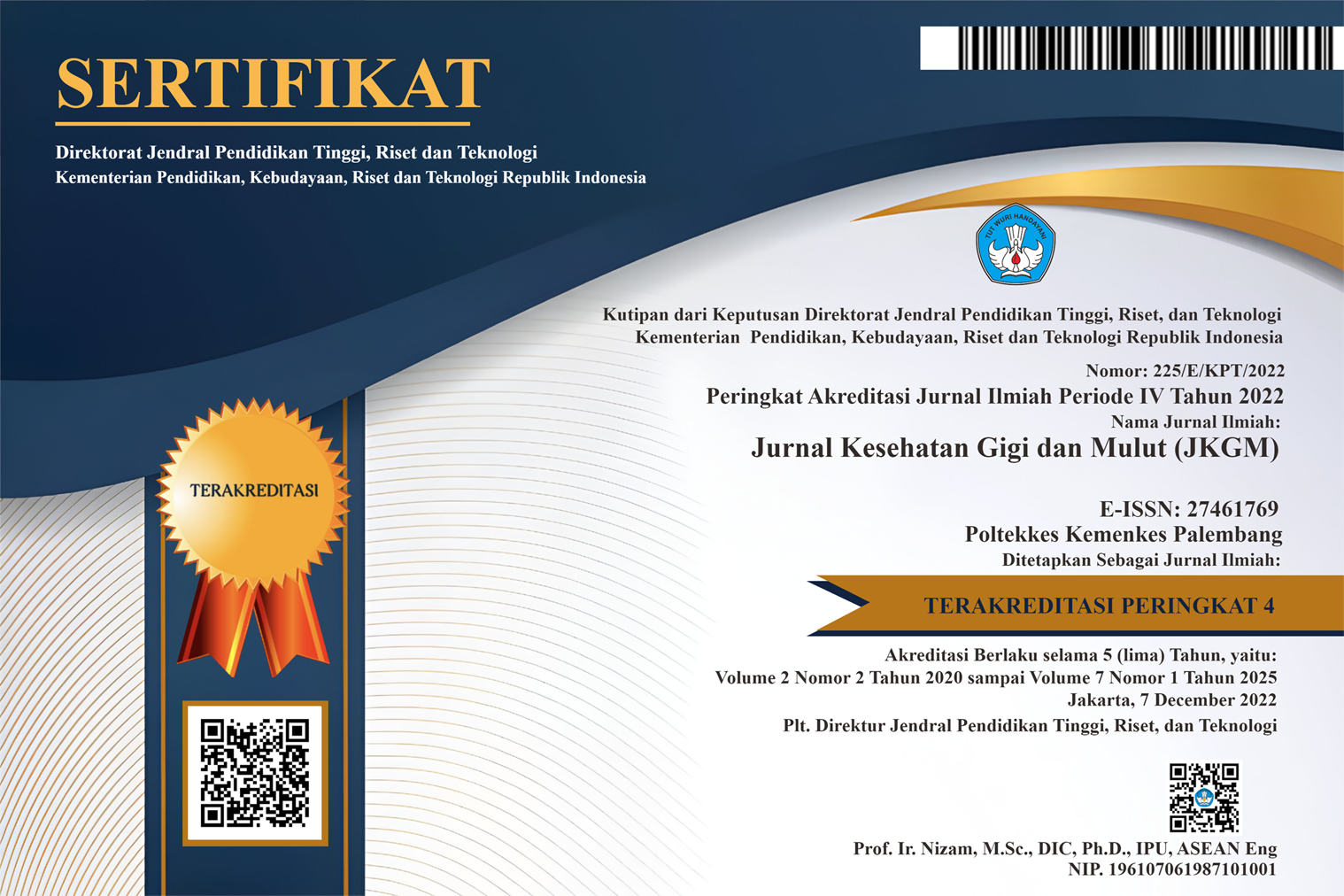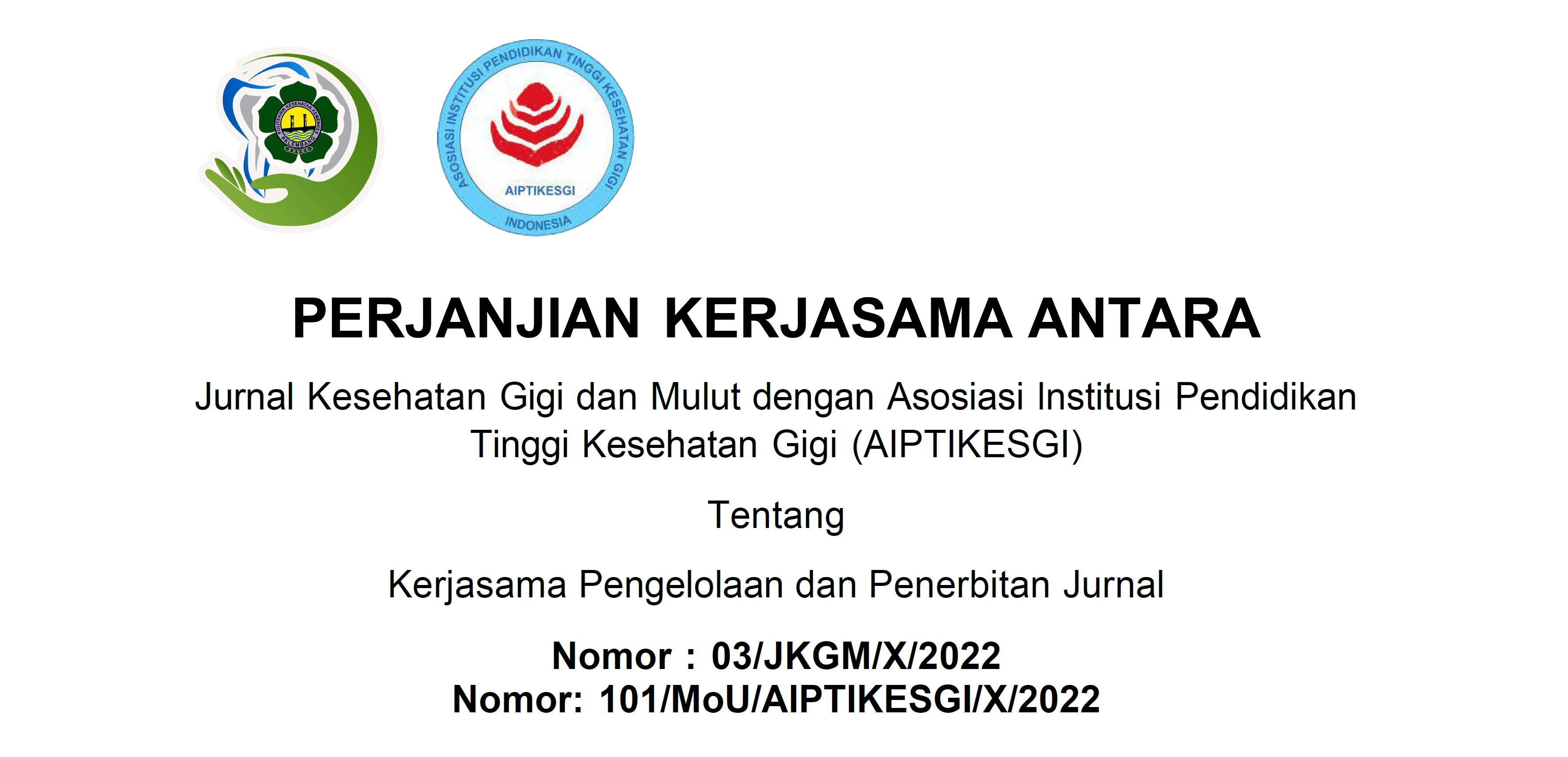PENGARUH PENYULUHAN MEDIA DENTAL STORY STICKER TERHADAP TINGKAT PENGETAHUAN KESEHATAN GIGI DAN MULUT PADA SISWA SDN 22 BANDA ACEH
Abstract
The background of this study is that dental health counseling is often carried out, but the prevalence of dental caries in school-age children in Indonesia is still relatively high, exceeding the national target, namely DMFT <1. The success of school children's dental health counseling efforts cannot be separated from educational methods and the importance of the role of the media because it can support the learning process and can help understand the material. Through media, the message conveyed can be more interesting and easy to understand. The purpose of this study is to determine the effect of counseling using dental story sticker media on the level of knowledge of dental and oral health in grade I students of SD Negeri 22 Banda Aceh. This research methodology uses the Quasi-Experimental method with one group pretest-postest design. Determination of samples in this study using a saturated sample technique totaling 30 students. This research was carried out at SDN 22 Banda Aceh. The results showed that the average knowledge score of students before being given counseling using dental story stickers was 7.53 then increased to 12.17 after being given counseling using dental story stickers. based on paired t-test P=0.001 (p<0.05) so that there is an influence of dental and oral health counseling on dental and oral health knowledge using dental story stickers. The conclusion of the research results that there was a significant increase in knowledge of dental and oral health after counseling with dental story stickers. Advice Expected to students with dental health counseling to be applied in everyday life.
References
Arikunto. (2010). Prosedur Penelitian Suatu Pendekatan Praktek (Rineka Cipta (ed.)). Rineka Cipta.
Aripin, S., Sarumaha, L., & Sinaga, M. N. (2020). Implementasi Metode Laplacian of Gaussian Dalam Deteksi Tepi Citra Gigi Berlubang. Sainteks, 393–396.
Aulia, H., Laksmiastuti, S. R., Widhianingsih, D., Gigi, F. K., Trisakti, U., Tapa, J. K., Petamburan, K. G., & Barat, K. J. (2021). Pengetahuan Anak Tentang Kesehatan Gigi dan Mulut Sebelum dan Sesudah Dilakukan DHE dengan Pembuatan Video Edukasi (Kajian pada Siswa Kelas III SDIT Alamy Subang). 2(1), 55–62.
Donsu, J, D, T. (2017). Psikologi Keperawatan (Cetakan I). Pustaka Baru.
Halimah, H., Herlina, R., & Ibraar Ayatullah, M. (2019). Efektifitas penyuluhan antara metode ceramah dengan pengisian teka teki silang terhadap pengetahuan dan tingkat kebersihan gigi dan mulut murid MTS Ar-Raudhatul Islamiyah, Mempawah. Journal of Oral Health Care, 7(1), 09–15. https://doi.org/10.29238/ohc.v7i1.340
Husna, N., & Prasko, P. (2019). Efektivitas Penyuluhan Kesehatan Gigi Dengan Menggunakan Media Busy Book Terhadap Tingkat Pengetahuan Kesehatan Gigi Dan Mulut. Jurnal Kesehatan Gigi, 6(1), 51.
https://doi.org/10.31983/jkg.v6i1.4408
Jumartin Gerung. (2020). Desain Media Untuk Promosi Kesehatan (Teori dan Praktek).
Ketut, N., Dosen, R., Kesehatan, J., & Poltekkes Denpasar, G. (2017). Bau Mulut (Halitosis). Jurnal Kesehatan Gigi, 5(1), 25–29.
http://indrax.wordpress.com
Mukhbitin, F. (2018). Gambaran Kejadian Karies Gigi Pada Siswa Kelas 3 Mi Al-Mutmainnah. Jurnal Promkes, 6(2), 155–166.
Notoadmodjo, S. (2012). Promosi Kesehatan & Prilaku Kesehatan. In Jakarta : EGC.
Nugraheni, H., Sadimin, S., & Sukini, S. (2019). Determinan Perilaku Pencegahan Karies Gigi Siswa Sekolah Dasar Di Kota Semarang. Jurnal Kesehatan Gigi, 6(1), 26. https://doi.org/10.31983/jkg.v6i1.4404
Puspita, N. H., Mahirawatie, I. C., & Larasati, R. (2022). Media Monopoli Kesehatan Gigi Terhadap Peningkatan Pengetahuan Dan Sikap Pemeliharaan Kebersihan Gigi Dan Mulut. Jurnal Ilmiah Keperawatan Gigi (JIKG), 3(2), 194–202.
Putri, Y. L., Mujiyati, M., & Syahniati, T. (2021). Pengaruh Promosi Kesehatan Menggunakan Media Menempel Gambar (Dental Story Sticker) Terhadap Pengetahuan Anak Dalam Menjaga Kebersihan Gigi Dan Mulut. Jurnal Kesehatan Gigi Dan Mulut (JKGM), 3(1), 31–34.
https://doi.org/10.36086/jkgm.v3i1.760
Qodr, T. S. (2020). Media Pembelajaran Game Geograpiea untuk Anak Sekolah Dasar di Era Digital. Journal of Curriculum Indonesia, 3(2), 45. https://doi.org/10.46680/jci.v3i2.29
Ramadhany, V., Laksmiastuti, S., & Dwimega, A. (2021). Gambaran Pengetahuan Orang Tua tentang Kesehatan Gigi dan Mulut Anak di Masa Pandemi Covid-19. Jurnal Kedokteran Gigi Terpadu, 2(2), 65–67.
Rosyadi, M. I. (2020). Pengembangan Kognitf Pada Anak Usia Dini Melalui Media Bermain. Al-Hikmah Way Kanan, 01(01), 1–6.
Tanu, N. P., Manu, A. A., & Ngadilah, C. (2019). Hubungan Frekuensi Menyikat Gigi dengan Tingkat Kejadian Karies. Dental Therapist Journal, 1(1), 39–43. https://doi.org/10.31965/dtl.v1i1.357
Titin Samarni. (2021). Pengaruh Penyuluhan Dengan Media Phantom Gigi Menyikat Gigi Pada Anak Sekolah Dasar Negeri 1 Supat Karya Tulis Ilmiah Oleh Titin Sumarni Jurusan Kesehatan Gigi.
Tyas, S. P., Meinitasari, E., & Septianingrum, N. M. A. N. (2018). Inovation edible film extract of basil leaft (Ocimum Americanum L) as anti halitosis inovasi edible film ekstrak daun kemangi (Ocimum Americanum L) sebagai anti halitosis. Prosiding Anual Pharmacy Conference 3rd, 33–39.
Veronica, N. (2018). Pedagogi: Jurnal Anak Usia Dini Dan Pendidikan Anak Usia Dini Permainan Edukatif Dan Perkembangan Kognitif Anak Usia Dini. Pedagogi: Jurnal Anak Usia Dini Dan Pendidikan Anak Usia Dini, 4(2), 49–55.
Copyright (c) 2024 Jurnal Kesehatan Gigi dan Mulut (JKGM)

This work is licensed under a Creative Commons Attribution-ShareAlike 4.0 International License.
Authors who publish with this journal agree to the following terms:
- Authors retain copyright and grant the journal right of first publication with the work simultaneously licensed under a Creative Commons Attribution License that allows others to share the work with an acknowledgement of the work's authorship and initial publication in this journal.
- Authors are able to enter into separate, additional contractual arrangements for the non-exclusive distribution of the journal's published version of the work (e.g., post it to an institutional repository or publish it in a book), with an acknowledgement of its initial publication in this journal.
- Authors are permitted and encouraged to post their work online (e.g., in institutional repositories or on their website) prior to and during the submission process, as it can lead to productive exchanges, as well as earlier and greater citation of published work















